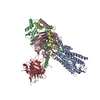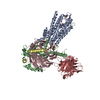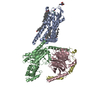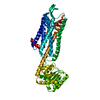[English] 日本語
 Yorodumi
Yorodumi- PDB-7w41: Crystal Structure of Human Gastrin Releasing Peptide Receptor in ... -
+ Open data
Open data
- Basic information
Basic information
| Entry | Database: PDB / ID: 7w41 | |||||||||||||||||||||
|---|---|---|---|---|---|---|---|---|---|---|---|---|---|---|---|---|---|---|---|---|---|---|
| Title | Crystal Structure of Human Gastrin Releasing Peptide Receptor in complex with the antagonist PD176252 | |||||||||||||||||||||
 Components Components | Gastrin-releasing peptide receptor,GlgA glycogen synthase | |||||||||||||||||||||
 Keywords Keywords | MEMBRANE PROTEIN / GPCR / Gastrin Releasing Peptide Receptor | |||||||||||||||||||||
| Function / homology |  Function and homology information Function and homology informationresponse to external biotic stimulus / positive regulation of respiratory gaseous exchange / positive regulation of behavioral fear response / alpha-1,4-glucan glucosyltransferase (UDP-glucose donor) activity / neuropeptide receptor activity / psychomotor behavior / neuropeptide binding / G protein-coupled peptide receptor activity / motor behavior / social behavior ...response to external biotic stimulus / positive regulation of respiratory gaseous exchange / positive regulation of behavioral fear response / alpha-1,4-glucan glucosyltransferase (UDP-glucose donor) activity / neuropeptide receptor activity / psychomotor behavior / neuropeptide binding / G protein-coupled peptide receptor activity / motor behavior / social behavior / Peptide ligand-binding receptors / regulation of cell population proliferation / phospholipase C-activating G protein-coupled receptor signaling pathway / G alpha (q) signalling events / learning or memory / G protein-coupled receptor signaling pathway / plasma membrane Similarity search - Function | |||||||||||||||||||||
| Biological species |  Homo sapiens (human) Homo sapiens (human)  Pyrococcus abyssi GE5 (archaea) Pyrococcus abyssi GE5 (archaea) | |||||||||||||||||||||
| Method |  X-RAY DIFFRACTION / X-RAY DIFFRACTION /  SYNCHROTRON / SYNCHROTRON /  MOLECULAR REPLACEMENT / Resolution: 2.952 Å MOLECULAR REPLACEMENT / Resolution: 2.952 Å | |||||||||||||||||||||
 Authors Authors | Peng, S. / Zhan, Y. / Zhang, H. | |||||||||||||||||||||
| Funding support |  China, 6items China, 6items
| |||||||||||||||||||||
 Citation Citation |  Journal: Proc Natl Acad Sci U S A / Year: 2023 Journal: Proc Natl Acad Sci U S A / Year: 2023Title: Structures of human gastrin-releasing peptide receptors bound to antagonist and agonist for cancer and itch therapy. Authors: Shuman Peng / Yuting Zhan / Dongqi Zhang / Lu Ren / Anqi Chen / Zhou-Feng Chen / Haitao Zhang /   Abstract: Gastrin releasing peptide receptor (GRPR), a member of the bombesin (BBN) G protein-coupled receptors, is aberrantly overexpressed in several malignant tumors, including those of the breast, ...Gastrin releasing peptide receptor (GRPR), a member of the bombesin (BBN) G protein-coupled receptors, is aberrantly overexpressed in several malignant tumors, including those of the breast, prostate, pancreas, lung, and central nervous system. Additionally, it also mediates non-histaminergic itch and pathological itch conditions in mice. Thus, GRPR could be an attractive target for cancer and itch therapy. Here, we report the inactive state crystal structure of human GRPR in complex with the non-peptide antagonist PD176252, as well as two active state cryo-electron microscopy (cryo-EM) structures of GRPR bound to the endogenous peptide agonist gastrin-releasing peptide and the synthetic BBN analog [D-Phe, β-Ala, Phe, Nle] Bn (6-14), in complex with G heterotrimers. These structures revealed the molecular mechanisms for the ligand binding, receptor activation, and G proteins signaling of GRPR, which are expected to accelerate the structure-based design of GRPR antagonists and agonists for the treatments of cancer and pruritus. | |||||||||||||||||||||
| History |
|
- Structure visualization
Structure visualization
| Structure viewer | Molecule:  Molmil Molmil Jmol/JSmol Jmol/JSmol |
|---|
- Downloads & links
Downloads & links
- Download
Download
| PDBx/mmCIF format |  7w41.cif.gz 7w41.cif.gz | 111.7 KB | Display |  PDBx/mmCIF format PDBx/mmCIF format |
|---|---|---|---|---|
| PDB format |  pdb7w41.ent.gz pdb7w41.ent.gz | 82.4 KB | Display |  PDB format PDB format |
| PDBx/mmJSON format |  7w41.json.gz 7w41.json.gz | Tree view |  PDBx/mmJSON format PDBx/mmJSON format | |
| Others |  Other downloads Other downloads |
-Validation report
| Summary document |  7w41_validation.pdf.gz 7w41_validation.pdf.gz | 727.7 KB | Display |  wwPDB validaton report wwPDB validaton report |
|---|---|---|---|---|
| Full document |  7w41_full_validation.pdf.gz 7w41_full_validation.pdf.gz | 736 KB | Display | |
| Data in XML |  7w41_validation.xml.gz 7w41_validation.xml.gz | 19.1 KB | Display | |
| Data in CIF |  7w41_validation.cif.gz 7w41_validation.cif.gz | 25.2 KB | Display | |
| Arichive directory |  https://data.pdbj.org/pub/pdb/validation_reports/w4/7w41 https://data.pdbj.org/pub/pdb/validation_reports/w4/7w41 ftp://data.pdbj.org/pub/pdb/validation_reports/w4/7w41 ftp://data.pdbj.org/pub/pdb/validation_reports/w4/7w41 | HTTPS FTP |
-Related structure data
| Related structure data |  7w3zC  7w40C  7f6gS S: Starting model for refinement C: citing same article ( |
|---|---|
| Similar structure data | Similarity search - Function & homology  F&H Search F&H Search |
- Links
Links
- Assembly
Assembly
| Deposited unit | 
| ||||||||
|---|---|---|---|---|---|---|---|---|---|
| 1 |
| ||||||||
| Unit cell |
|
- Components
Components
| #1: Protein | Mass: 54374.758 Da / Num. of mol.: 1 / Mutation: S127K,I157A,R259E Source method: isolated from a genetically manipulated source Source: (gene. exp.)  Homo sapiens (human), (gene. exp.) Homo sapiens (human), (gene. exp.)   Pyrococcus abyssi GE5 (archaea) Pyrococcus abyssi GE5 (archaea)Gene: GRPR, PAB2292 / Strain: GE5 / Orsay / Production host:  |
|---|---|
| #2: Chemical | ChemComp-8B8 / ( |
| Has ligand of interest | Y |
| Has protein modification | Y |
-Experimental details
-Experiment
| Experiment | Method:  X-RAY DIFFRACTION / Number of used crystals: 1 X-RAY DIFFRACTION / Number of used crystals: 1 |
|---|
- Sample preparation
Sample preparation
| Crystal | Density Matthews: 3.34 Å3/Da / Density % sol: 57.4 % |
|---|---|
| Crystal grow | Temperature: 294 K / Method: lipidic cubic phase / pH: 6.8 Details: 100mM MES, pH 6.8, 300mM Ammonium dihydrogen phosphate, 28% PEG 400, 5% polypropylene glycol P 400 |
-Data collection
| Diffraction | Mean temperature: 100 K / Serial crystal experiment: N |
|---|---|
| Diffraction source | Source:  SYNCHROTRON / Site: SYNCHROTRON / Site:  SSRF SSRF  / Beamline: BL18U1 / Wavelength: 1.033 Å / Beamline: BL18U1 / Wavelength: 1.033 Å |
| Detector | Type: PSI PILATUS 6M / Detector: PIXEL / Date: Nov 14, 2021 |
| Radiation | Protocol: SINGLE WAVELENGTH / Monochromatic (M) / Laue (L): M / Scattering type: x-ray |
| Radiation wavelength | Wavelength: 1.033 Å / Relative weight: 1 |
| Reflection | Resolution: 2.95→27.767 Å / Num. obs: 14852 / % possible obs: 96.9 % / Redundancy: 4 % / Rmerge(I) obs: 0.151 / Net I/σ(I): 8.14 |
| Reflection shell | Resolution: 2.95→3.06 Å / Rmerge(I) obs: 0.599 / Num. unique obs: 1449 |
- Processing
Processing
| Software |
| |||||||||||||||||||||||||||||||||||||||||||||||||||||||||||||||||||||||||||||||||||||||||||||||||||||||||||||||||||||||||||||||||||||||||||||||||||
|---|---|---|---|---|---|---|---|---|---|---|---|---|---|---|---|---|---|---|---|---|---|---|---|---|---|---|---|---|---|---|---|---|---|---|---|---|---|---|---|---|---|---|---|---|---|---|---|---|---|---|---|---|---|---|---|---|---|---|---|---|---|---|---|---|---|---|---|---|---|---|---|---|---|---|---|---|---|---|---|---|---|---|---|---|---|---|---|---|---|---|---|---|---|---|---|---|---|---|---|---|---|---|---|---|---|---|---|---|---|---|---|---|---|---|---|---|---|---|---|---|---|---|---|---|---|---|---|---|---|---|---|---|---|---|---|---|---|---|---|---|---|---|---|---|---|---|---|---|
| Refinement | Method to determine structure:  MOLECULAR REPLACEMENT MOLECULAR REPLACEMENTStarting model: 7F6G Resolution: 2.952→27.767 Å / Cor.coef. Fo:Fc: 0.907 / Cor.coef. Fo:Fc free: 0.878 / SU B: 0.1 / SU ML: 0 / Cross valid method: FREE R-VALUE / ESU R: 0.465 / ESU R Free: 0.532 Details: Hydrogens have been added in their riding positions
| |||||||||||||||||||||||||||||||||||||||||||||||||||||||||||||||||||||||||||||||||||||||||||||||||||||||||||||||||||||||||||||||||||||||||||||||||||
| Solvent computation | Ion probe radii: 0.8 Å / Shrinkage radii: 0.8 Å / VDW probe radii: 1.2 Å / Solvent model: MASK BULK SOLVENT | |||||||||||||||||||||||||||||||||||||||||||||||||||||||||||||||||||||||||||||||||||||||||||||||||||||||||||||||||||||||||||||||||||||||||||||||||||
| Displacement parameters | Biso mean: 70 Å2
| |||||||||||||||||||||||||||||||||||||||||||||||||||||||||||||||||||||||||||||||||||||||||||||||||||||||||||||||||||||||||||||||||||||||||||||||||||
| Refinement step | Cycle: LAST / Resolution: 2.952→27.767 Å
| |||||||||||||||||||||||||||||||||||||||||||||||||||||||||||||||||||||||||||||||||||||||||||||||||||||||||||||||||||||||||||||||||||||||||||||||||||
| LS refinement shell |
|
 Movie
Movie Controller
Controller




 PDBj
PDBj













